China Medical System (CMS) achieved a secondary listing on the Singapore Exchange yesterday.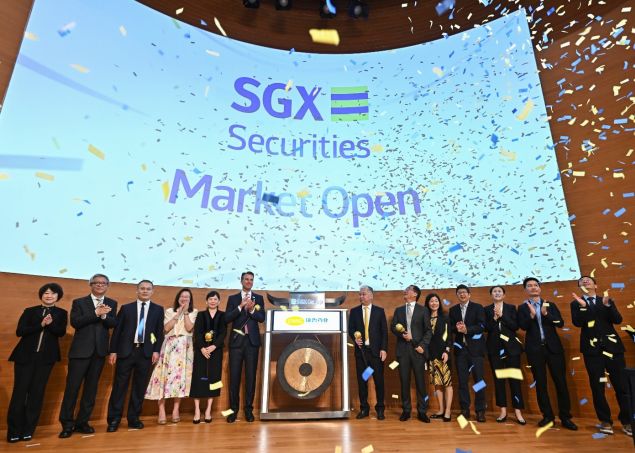 L-R: Ms. Wang Linlang (GM of Ophthalmology Business, CMS Vision), Mr. Fan Jie (Deputy GM), Mr. Jiang Qingfu (GM of Cardio-cerebrovascular/ Gastroenterology Business, Shenzhen Kangzhe), Ms. Carol Fong (Group CEO of CGS International Securities), Ms. Chen Yanling (Executive Director and CFO), Mr. Pol de Win (Senior MD of SGX Group), Mr. Lam Kong (Founder, Chairman, Chief Executive and President), Mr. Chen Hongbing (Non-executive Director), Ms. Luo Ying (Independent Non-executive Director), Mr. Ma Lieyi (GM), Ms. Li Yufang (GM), Mr. Huang Anjun (CEO of Skin Health Business, DERMAVON), Mr. Fu Zhongming (GM of the Human Resources Centre).
L-R: Ms. Wang Linlang (GM of Ophthalmology Business, CMS Vision), Mr. Fan Jie (Deputy GM), Mr. Jiang Qingfu (GM of Cardio-cerebrovascular/ Gastroenterology Business, Shenzhen Kangzhe), Ms. Carol Fong (Group CEO of CGS International Securities), Ms. Chen Yanling (Executive Director and CFO), Mr. Pol de Win (Senior MD of SGX Group), Mr. Lam Kong (Founder, Chairman, Chief Executive and President), Mr. Chen Hongbing (Non-executive Director), Ms. Luo Ying (Independent Non-executive Director), Mr. Ma Lieyi (GM), Ms. Li Yufang (GM), Mr. Huang Anjun (CEO of Skin Health Business, DERMAVON), Mr. Fu Zhongming (GM of the Human Resources Centre).
The company's primary listing is on the Hong Kong Stock Echange.
Below is our email interview with the company.
|
1. With a secondary listing on the SGX, this may be the first time that Singapore investors have heard of your company. Help us understand the business model. Bring us up to date on the company’s performance. Give us a rounded picture by touching on challenges and opportunities in the near term. With over 30 years of experience in China’s pharmaceutical market, CMS is a platform company linking pharmaceutical innovation and commercialization with strong product lifecycle management capability, dedicated to providing competitive products and services to meet unmet medical needs.
|
2. How did CMS’s business perform in 2024?
In 2024, the Group recorded a turnover of RMB7,469.0 million, representing a year-on-year decrease of 6.8% (2023: RMB8,013.3 million). In the case that all medicines were directly sold by the Group, the turnover was RMB8,621.6 million, representing a year-on-year decrease of 9.0% (2023: RMB9,472.2 million).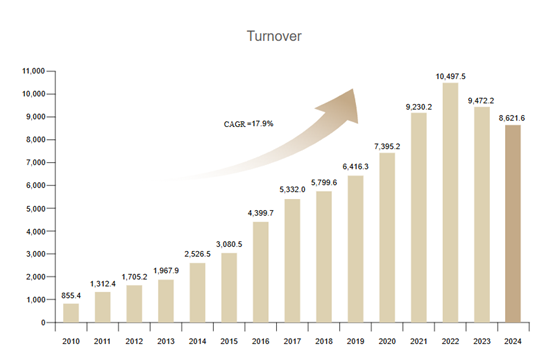
The profit for the year of 2024 was RMB1,613.1 million, representing a year-on-year decrease of 32.3% (2023: RMB2,384.4 million).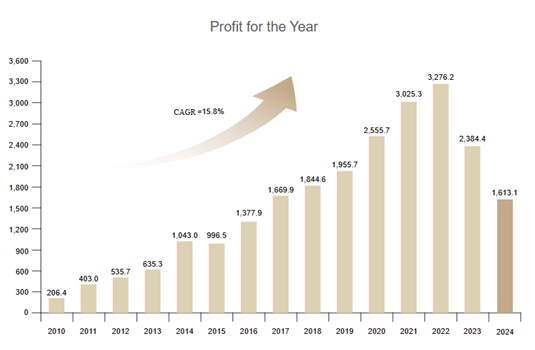
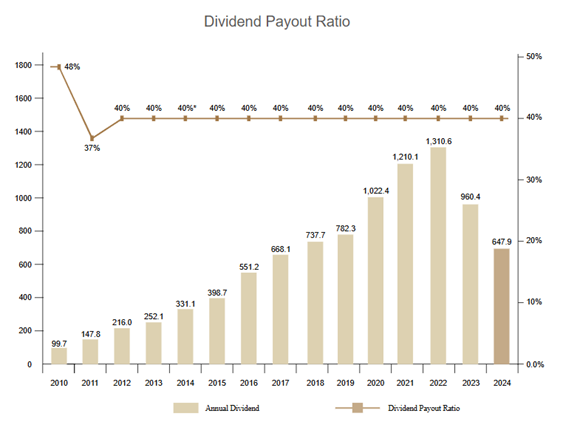
For CMS, 2024 was both a “year of restructuring” amidst challenges and a “year of breakthroughs” with emerging potentials. The Group’s innovative drugs have entered commercialization stage, with five of them (covering six indications) making strong debuts in the market. Meanwhile, the pressure from National Volume Based Procurement (“National VBP”) has been gradually eased, leading to increasingly stable operational momentum.
3. Can you elaborate why CMS’s revenue took a hit in 2024?
In 2024, CMS’s three original drugs were affected by National VBP, namely, Deanxit (included in the seventh batch of National VBP), Plendil and Ursofalk (included in the eighth batch of National VBP).
These batches were implemented successively in November 2022 and July 2023 respectively, and forementioned three original drugs were not selected, which had a negative impact on CMS’s financial performance.
However,the impact has eased. Excluding these three National VBP products, the majority of CMS’s core products are exclusive/branded and innovative products. During 2024, in the case that all medicines were directly sold by CMS, the total revenue of the non-national VBP exclusive products and innovative products was RMB4,551.3 million, representing a year-on-year increase of 4.1%, accounting for 52.8% of the Group’s revenue.
CMS saw a topline rebound in 2H2024 driven by progress in commercialising innovative drugs and the continued growth of non-VBP exclusive products.
4. How is CMS dealing with the challenges from China’s the National VBP?
We have been shifting focus to exclusive and innovative drugs that aren’t affected by the government’s VBP rules. Sales from these products without generics actually grew by 4.1% in 2024 and now make up over half of CMS’s revenue.
For our innovative R&D, we focus on globally first-in-class and best-in-class innovative products, and has developed a differentiated pipeline of approximately 40 innovative products, among which 5 have already been approved and successfully launched in China.
As innovative drugs gradually enter large-scale clinical application, with a continuous pipeline of high-quality innovative drugs being approved for the market and the steady growth of exclusive/branded drugs, the company is set to enter a new cycle of high-quality and sustainable development driven by exclusive and innovative drugs. Our revenue, net profit, and ROE are all expected to return to growth.
Moreover, CMS is positioning emerging markets as a strategic high ground for its "second growth curve." By Advancing our pharmaceutical industry internationalization strategy, and accelerating the construction of the full pharmaceutical value chain of R&D, manufacturing and commercialization, the company is building a high-quality, resilient, and sustainable growth model.
5. Does CMS expect the VBP policy to include innovative products in the future? What would CMS do in such a scenario?
Since the pilot implementation of the ‘4+7’ city centralised drug procurement programme in 2019, National VBP has become a routine practice. The policy goal of the National VBP is to bring down drug prices by relying on VBP and a bidding process organised by the state.
Under this policy, public hospitals are required to participate in the national procurement of specified drugs, with procurement volumes set at 60%-80% of their previous annual usage levels. The policy primarily targets off-patent drugs with high prescribing volumes in hospitals and with intense homogeneous generics competition, rather than innovative or exclusive products with no such homogeneous generics competition.
Therefore, innovative products with patents and exclusive products without generics will not be affected by VBP.
6. Apart from a secondary listing on SGX, CMS earlier announced a proposed spin-off of subsidiary Dermavon. Briefly what does CMS hope to achieve with these two moves?
a) Our listing in SGX further enhances our presence in the international capital markets. At the same time, by leveraging Singapore’s strengths as a hub for global innovation and multinational headquarters, we are advancing our pharmaceutical industry internationalization strategy, accelerating the construction of the full pharmaceutical value chain of R&D, manufacturing and commercialization, and working hand-in-hand with our partners to promote the growth of the pharmaceutical industry in emerging markets and deliver meaningful benefits to patients worldwide.
b) Regarding the proposed Dermavon spin-off:
Dermavon is China’s leading innovative pharmaceutical company specialized in skin health, with unified operations combining the R&D, production, and sales of dermatological prescription products and dermatology-grade skincare products.
According to the CIC Report, Dermavon has the most extensive coverage of dermatology indications, and its revenue generated from dermatological prescription products in 2024 ranked first among Chinese innovative pharmaceutical companies.
The spin-off could provide a new financing platform for Dermavon, allow better focus of our Group’s resources, establish independent and improved corporate images for our Group and Dermavon, and enhance the business profile for Dermavon.
For more, please see our announcements posted on the HK Stock Exchange website.
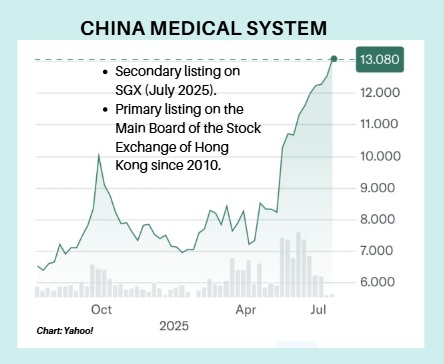
7. Did CMS make progress with new drugs in 2024?
Yes, in 2024, CMS continued to make breakthroughs in the R&D of novel products, with one innovative drug approved for marketing, one additional indication approved, NDAs submitted for two novel drugs, three innovative drug collaborations and three medical aesthetic product collaborations established, and over 10 clinical trial projects progressing smoothly.
8. What are the main challenges CMS faces now? And where does CMS see the best opportunities to grow?
We don’t see any new challenges coming for our business development, and the pressure from National VBP has been gradually eased, leading to increasingly stable operational momentum. However, we are building the new growth engines and to form us a “New CMS” with “New Rise”.
- Innovative R&D
With a combination of collaborative R&D and in-house R&D, CMS has a pipeline of about 40 new drugs in development, with five of them(covering six indications) — LUMEBLUE, VALTOCO, ILUMETRI, METOJECT, and VELPHORO making strong debuts in the market, and we expect to launch more every year.
- Speciality therapeutic fields focused
We continue to promote the in-depth development of our advantageous specialty fields and expand business boundaries, strengthening the competitiveness of the cardio-cerebrovascular/gastroenterology/ophthalmology/ skin health businesses.
Among them, the skin health business has become a leading enterprise in its field, bringing economies of scale in specialty therapeutic field.
- Internationalization Strategy
With resource spillover, we are comprehensively advancing industrial internationalization to capture incremental growth from emerging markets (such as SEA and Middle East markets).
CMS’s secondary listing on SGX empowers our APAC Expansion, extending our China's advantages, achieving full-chain synergy in R&D, Production, Sales & Investment.
These three strategies navigate us to the second growth curve.
|
9. Of all Southeast Asian countries, where is CMS’ business expanding the fastest? Are there plans to focus on any particular country within Southeast Asia first?
10. Why did CMS acquire a CDMO in Singapore, instead of a neighbouring country with cheaper production costs? CMS selected Singapore for its CDMO acquisition (PharmaGend) due to several strategic advantages: Global standard manufacturing: The facility holds certifications from the US FDA and Singapore’s HSA, ensuring compliance with stringent global standards, which is critical for serving both ASEAN and global markets. Supply chain resilience: Singapore’s advanced infrastructure and trade connectivity mitigate risks from global disruptions, aligning with ASEAN’s demand for regional health security. Market access: proximity to multinational partners and biotech hubs accelerates collaborations. Long-term credibility: Singapore’s stable business environment and IP protections reinforcing CMS’s position as a trusted regional leader. |
11. What is the pharmaceutical markets for Southeast Asian countries like? How has it differed from China and how is CMS managing this?
Southeast Asia’s market is one of the fastest-growing in the world, driven by a population of nearly 700 million, divided across 10+ countries with varying regulations, payment systems, and language barriers.
The key differences between Southeast Asia and China are from several perspectives:
- Market fragmentation vs. centralization: Southeast Asia is a highly fragmented region with 11 countries each having distinct regulatory frameworks, reimbursement systems, and cultural preferences. Where in China, a centralized, national initiatives, like Volume-Based Procurement (VBP), would lead to rapid and price-sensitive adoption.
- Pricing and affordability dynamics: Relatively, Southeast Asia countries are more price-sensitive, with generics and biosimilars dominating due to lower per capital healthcare spending in most of the ASEAN countries. China, while also cost-conscious, can now support dual-tier pricing due to a much larger economy base and fundamental growth from past three decades.
- Supply chain and manufacturing: Southeast Asia nowadays still mostly reliant on imported drugs (70% of pharmaceutical products are sourced externally), with logistics could potentially become bottlenecks, and capacity of local manufacturing would become an important differentiator for regional supply sustainability. In contrary, China is in general self-sufficient in API and production, with a mature domestic supply chain.
To navigate these differences, CMS has adopted a list of approaches to ensure sustainable development in the region:
- Rxilient, CMS group’s Singapore-based subsidiary, has built in-country teams in many markets to handle registration, distribution, and local commercialization.
- CMS’s CDMO facility, PharmaGend, ensures supply chain resilience and compliance with ASEAN and global stringent GMP standards, sufficient supply (1 billion tablet per year capacity), and cost-effective drug manufacturing.
|
12. Tell us something about your long-time leader, Mr Lam Kong. Mr. Lam Kong is the Founder, Chairman, Chief Executive and President of CMS. The Company is founded by him in 1992 in Shenzhen, China. Mr. Lam is responsible for the creation, implementation and management of the CMS’s development and growth strategy.
|






